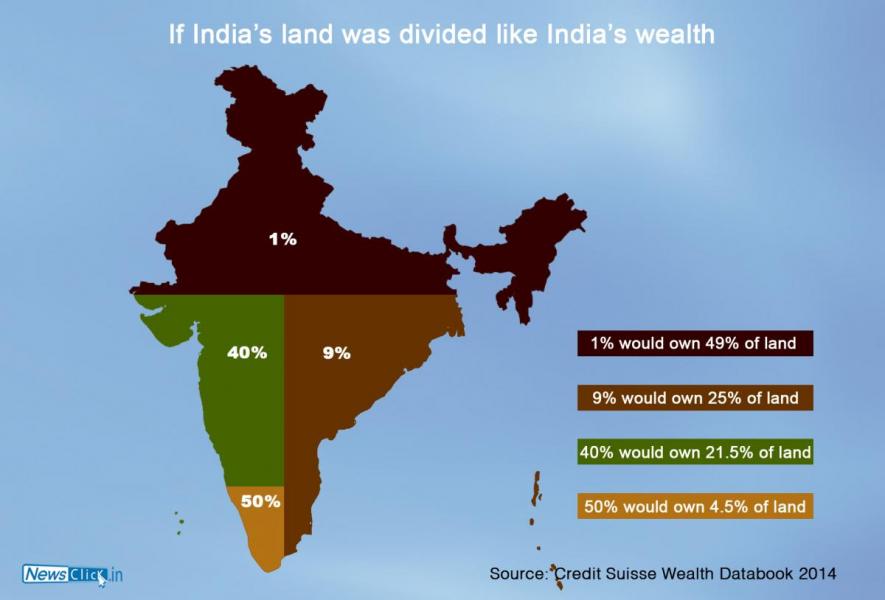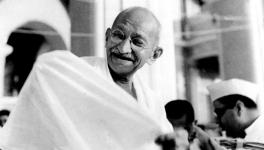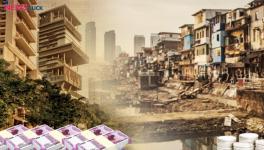The Phenomenal Increase in Wealth Inequality
CREDIT Suisse brings out a Global Wealth Report every year. The current year’s report takes up for specific discussion the issue of wealth inequality. The term “wealth” in the report covers only household wealth and refers to the value of assets at current prices; it includes in other words capital gains and hence the effects of speculative factors.
There are two points to be noted while discussing the figures given in the Credit Suisse report. First, the term “wealth” used in the report differs from capital stock, or real assets in general. This is because, even though all wealth refers ultimately to the ownership of real assets, with financial assets being nothing else but claims upon real assets, the prices of real assets and the prices of claims upon real assets can move very disparately. Thus, when there is a stock market “bubble”, the value of wealth in the form of, say, equities increases; but there may not be any corresponding increase in the value of the real assets of the firm whose equities have thus increased in value.
Secondly, in any international comparison there is an important issue relating to the appropriate exchange rate at which the value of wealth in different countries should be made commensurable. The number of Indian billionaires among the top 100 in the world for instance would vary greatly depending upon whether we convert their wealth in rupees into US dollars at the official exchange rate or at some PPP exchange rate (which typically gives the rupee a much higher value). This second problem however does not arise if we are comparing changing wealth inequality across countries, for that involves only the relative distribution of wealth within each country, and does not need any conversion of different currencies into dollars. We shall confine ourselves here to this latter exercise.
The first thing to notice is the remarkable increase in wealth inequality that has occurred in the capitalist world after the 1970s, ie, from the time that the new ascendancy of finance capital began. In the United States for instance between 1910 and 1970 the share of the top 10 percent of households in total household wealth declined from 81 percent to 64 percent; after 1970 it has increased markedly from 64 to 75 percent. Likewise the share of the top 1 percent of households in total wealth declined between 1910 and 1970 from 45 to 28 percent; but it has increased thereafter from 28 to 34 percent. And more or less the same picture holds for the other advanced capitalist economies.
But within this latter period when wealth inequality has increased, this increase has been substantially accomplished by 2000; if we take 2000 to 2014, then the share of the top decile or the top percentile in total wealth has not, on the whole, increased much further within the advanced capitalist world. In this latter period however the real dramatic increase has taken place in wealth inequality within the so-called “emerging market economies”.
As on 2014, “very high inequality”, defined as a situation where the top decile has more than 70 percent of the total household wealth, characterised Hong Kong, Switzerland and the United States among the advanced economies. But it characterised as many as a dozen “emerging market economies”, namely Argentina, Brazil, Egypt, India, Indonesia, Malaysia, Peru, Philippines, Russia, South Africa, Thailand and Turkey. (China and Taiwan are among the “high inequality”, as distinct from “very high inequality”, countries, where the share of the top decile in total household wealth is above 60 percent but less than 70 percent).
What is more, between 2000 and 2014, among the economies where there was what the Report calls a situation of “rapid rise” in inequality, defined as 0.5 percentage-point increase, or more, per annum in the share of the top decile in total household wealth over the reference period, these so-called “emerging market economies” were well-represented. “Rapid rise” occurred in China, Egypt, Hong Kong, Turkey, Korea, India, Russia, Argentina and Taiwan. It is as if the wave of rising wealth inequality, starting from the advanced capitalist world, spread across to the “emerging market economies” over time.
DANGEROUS CONSEQUENCES
Though the Credit Suisse report naturally does not say so, this wave itself is inextricably linked to the process of “globalisation” unleashed under the hegemony of international finance capital. It weakened trade unions and the working class movement in general, added greatly to the muscles of capital which could now hold the threat of leaving the shores of the country if its diktat was disobeyed, and hence forced each nation-State to bend to its will in order to prevent capital flight. But its spread across the globe has brought about an immense change whose social and political consequences are extremely dangerous. This change amounts to a veritable rolling back of the democratic advance made by the people over large parts of the world in the course of the last several decades.
Even among the countries picked out by the Credit Suisse report as exhibiting a “rapid rise” in wealth inequality, however, India stands out. The increase in wealth inequality in India between 2000 and 2014, the period under study, has been truly phenomenal. And this comes out not so much from the percentage share of the top decile in total household wealth, which, though it increased from 65.9 to 74 over the period, was overshadowed by the increase in several other countries, as from the increase in the share of the top percentile. The share of the top 1 percent in the total wealth of households has increased from 36.80 percent in 2000 to a phenomenal 49 percent in 2014! The share of the top 1 percent in total wealth in India today is thus larger than the share of the top 1 percent has ever been in the United States, the archetypal capitalist economy, in its entire history over the last century.

In other words, within the top decile itself, if we take the 9 percent other than the top 1 percent, its share in total household wealth increased from about 19 percent in 2000 to 26 percent in 2014, which itself constitutes “rapid rise” by the definition given above. But the top 1 percent’s share rising by almost 1 percentage point each year between these two dates, has been a case of super “rapid rise”.
The very idea of a mere 1 percent of the households owning half the wealth is almost incredible. In addition, it is a higher figure than for the world as a whole. According to a calculation from the same report that appeared in The Hindu of December 8, 2014, the share of the top 1 percent for the world as a whole in 2014 was 48.20 percent compared to 49 percent for India. And what is more, the share of the top 1 percent in India has been rising much faster than for the world as a whole. In 2000, while it was 36.8 percent in India, it was 48.70 percent for the world as a whole; but by 2014, the share had increased to 49 percent for India compared to 48.20 for the world. For the world in other words the share had remain unchanged, or even marginally declined; but for India it had increased by close to 1 percentage point per year.
As already mentioned the share of the top 1 percent in the US is about 34 percent, and the US has one of the highest levels of wealth inequality in the advanced capitalist world, qualifying as we saw above to be categorised as having “very high inequality”. But compared to the 34 percent in the US, the top 1 percent in India owns as much as 49 percent of total household wealth! This is inequality with a vengeance, and an increase in inequality that is phenomenal by any standards.
Even the figures given in Credit Suisse however do not, in one sense, capture the real extent of inequality. They refer to the ownership of wealth and not to the command over wealth. If a middle class person holds, say, Rs 10 of equity in a company which has total equity of Rs100, and where an Ambani owns the majority equity, say Rs 51, then Ambani’s wealth will be Rs 51 and that of the middle class person Rs 10, according to the definition given in the report, on the basis of which inequality is measured. But in fact the control over capital is Rs 100 for Ambani and nil for the middle class person. It follows that for any given degree of inequality in wealth ownership, the inequality in control over wealth is far greater. Hence if the top 1 percent owns almost half of the total wealth, then the percentage of total wealth it controls must be far greater.
CONCENTRATION OF POWER
There are two tendencies necessarily associated with such concentration of wealth. First, such concentration of economic power inevitably leads to a concentration of political power. The super rich corporate-capitalist elite uses all kinds of devices to ensure this, from buying up legislators and State personnel, to controlling and making use of the print and electronic media, to funding elections of favoured candidates who would push its agenda, to financing and propping up communal-fascistic political groups.
Second, this concentration of economic-cum-political power is invariably used for bringing about a still greater concentration of such power. This has been clearly visible in India. The super rich corporate elite has used every device in its armoury to project Narendra Modi as the right person to lead the nation, and has largely financed his successful election. And in return the Modi government is introducing labour market “reforms”, cutting down social sector schemes and even the MGNREGS and diverting funds towards “boosting the confidence of the investors”, and has announced ambitious schemes of “disinvestment”, all of which are part of the agenda of the super-rich.
The preservation of democracy in the country, and the defence of the legacy of the anti-colonial struggle, requires that such concentration of power in the hands of the super rich must be broken. For this, it is absolutely necessary that the “neo-liberal” trajectory which produces such concentration of power and which ultimately and inevitably leads to the ascendancy of communal-fascism as the instrument through which such power is exercised, must be completely rolled back.
Courtesy: Peoples Democracy
Disclaimer: The views expressed here are the author's personal views, and do not necessarily represent the views of Newsclick
Get the latest reports & analysis with people's perspective on Protests, movements & deep analytical videos, discussions of the current affairs in your Telegram app. Subscribe to NewsClick's Telegram channel & get Real-Time updates on stories, as they get published on our website.
























